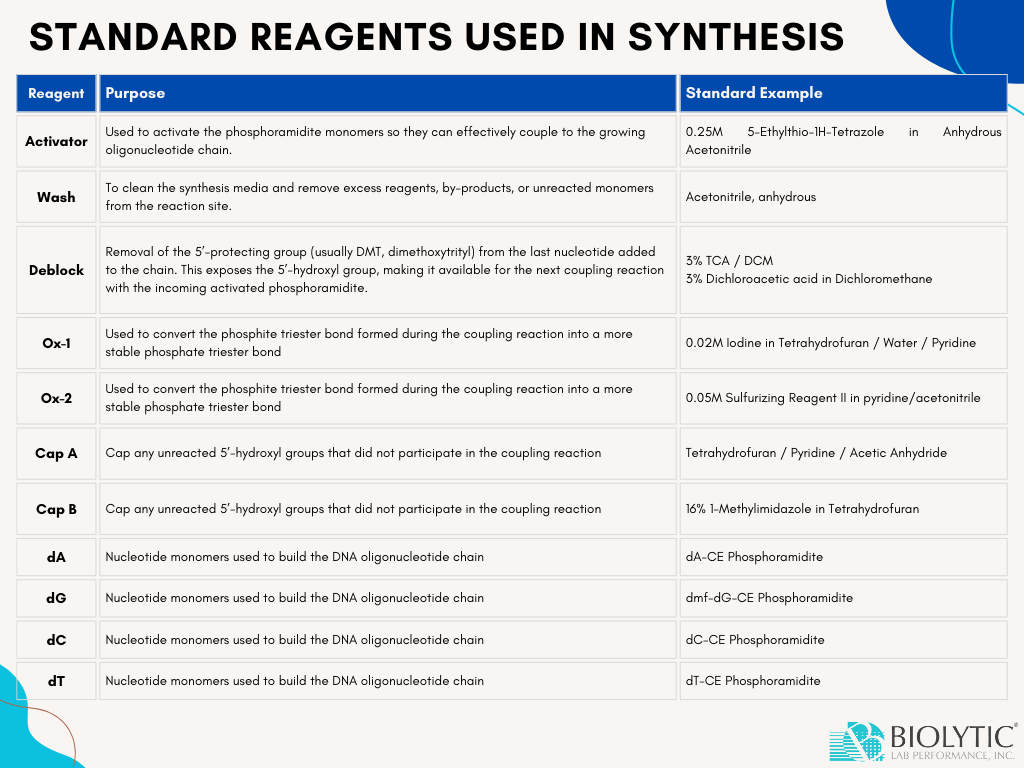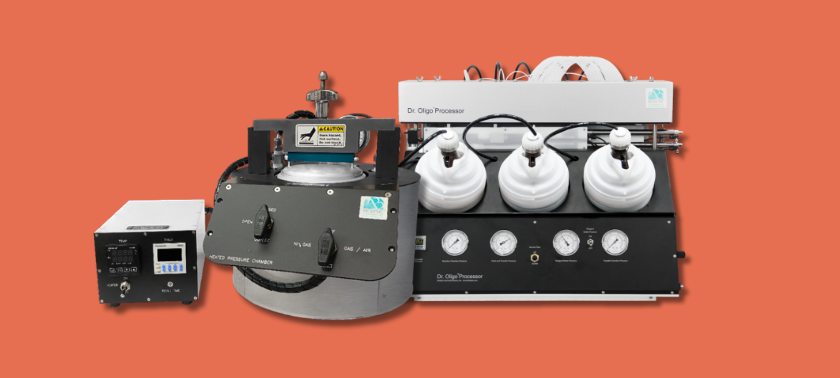If you’re new to oligonucleotide synthesis or looking to optimize your setup, ensuring you have all the necessary equipment and materials is crucial for a successful and efficient process. At Biolytic Lab Performance, Inc., we specialize in providing high-quality tools and products for oligonucleotide synthesis. This blog post offers a basic checklist to help you get started.

1. Choose the Right DNA/RNA Oligo Synthesizer
The foundation of any oligonucleotide synthesis setup is a reliable synthesizer. Researchers choose DNA RNA oligonucleotide synthesizers based on their specific research needs. Requirements such as oligo complexity and throughput are important questions that will drive your search for features in a synthesizer. Our Dr. Oligo Synthesizer is a versatile option that accommodates various synthesis scales and oligo lengths, making it a popular choice among researchers. Dr. Oligo Synthesizers are available in low-throughput, medium throughput, high-throughput, and ultra-high throughput with expansive reagent configurations for any oligo synthesis application.
2. Select the Appropriate Synthesis Media
Synthesis media like Controlled Pore Glass (CPG) or Polystyrene Beads are designed to anchor the first nucleotide during the synthesis process, providing a solid support that facilitates the sequential addition of nucleotide monomers.
Each type of synthesis media serves the purpose of providing a stable, controlled environment for oligonucleotide assembly. The choice between CPG and polystyrene, along with the selection of appropriate pore sizes, directly influences the efficiency, yield, and maximum length of the synthesized oligos.
3. Stock Up on Monomers (Phosphoramidites)
Phosphoramidites are the building blocks of your oligos. You’ll need purified nucleotide monomers—A, T, C, G for DNA or A, U, C, G for RNA. Additionally, consider acquiring specialty phosphoramidites if your research requires modified bases or linkers.

4. Gather Essential Reagents and Chemicals
Successful oligonucleotide synthesis requires a range of reagents:
- Activator: Such as tetrazole or ETT, used to activate the monomers.
- Oxidizing Agent: Typically an iodine solution, which converts phosphite to phosphate.
- Capping Reagent: To block any unreacted sites and prevent side reactions.
- Deblocking Reagent: Like TCA / DCM, used to remove caps to free up reaction sites for coupling additional nucleotides.
5. Prepare Synthesis Columns or Plates

Ensure you have synthesis columns or plates compatible with your oligo synthesizer and matched to the pore size of your synthesis media. These components are crucial for holding the synthesis media and supporting the oligo synthesis process.
6. Secure Necessary Solvents
Solvents play a critical role in oligonucleotide synthesis:
- Acetonitrile: Used for washing and delivering monomers to the synthesis columns.
Proper solvent management is essential for maintaining high synthesis efficiency and product purity.
7. Plan for Post-Synthesis Processing

After synthesis, you’ll need to process your oligos:
- Desalting or Purification Tools: Such as HPLC, cartridge purification systems, or the Dr. Oligo Processor to clean up your final product.
- Drying Apparatus: To remove solvents and prepare your oligos for storage or further use.
These steps are vital for ensuring the quality and stability of your synthesized oligos.
8. Implement Quality Control Measures
To verify the success of your synthesis, quality control is a must:
- Analytical Tools: Use MALDI-TOF or HPLC to confirm the identity and purity of your oligos.
- UV Spectrophotometer: An optional tool for measuring the concentration of your oligos.
9. Prioritize Safety Equipment
During the synthesis process, byproducts are released as a hazardous gas. Proper laboratory ventilation in the form of a fume hood is required to ensure safety.
- Fume Hood: Essential for safely handling volatile or hazardous chemicals.
10. Organize and Optimize Your Synthesis Protocols
A successful oligonucleotide synthesis process hinges on well-structured and optimized synthesis protocols. These protocols guide the synthesizer through each step of oligo assembly, ensuring precision and consistency in the final product. By carefully organizing and refining your protocols, you can achieve higher yields, better purity, and reproducible results.
Biolytic Lab Performance offers standard guaranteed to work synthesis protocols so you can start synthesizing quality oligos quickly. We offer custom synthesis protocol services and support for more complex oligos.
Conclusion: Start Synthesizing with Confidence
By following this basic checklist, you can confidently begin synthesizing oligos, knowing you have all the necessary tools and materials in place. At Biolytic Lab Performance, Inc., we’re here to support you every step of the way. Whether you need top-quality synthesis media and consumables, reliable DNA RNA oligo synthesizers, or expert technical support, we’re committed to helping you achieve success in your oligonucleotide synthesis endeavors.
For more information or to discuss your specific needs, contact us.
- Explore Dr. Oligo DNA RNA Synthesizers: Oligo / RNA / DNA Synthesizers (biolytic.com)
- Find Consumables including Synthesis Columns and Plates and more: DNA RNA Oligo Synthesis Consumables | Biolytic Lab Performance
- Automate downstream processes with Post-Synthesis Accessories: Small Laboratory Accessories and Equipment (biolytic.com)
- Contact us for oligo synthesis support: Biolytic Lab Performance, Inc | Contact Us





